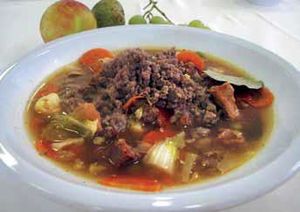Obara (stew) facts for kids
 |
|
| Type | Stew |
|---|---|
| Place of origin | Slovenia |
| Main ingredients | Meat or offal (intestines) or vegetables |
Obara is a traditional Slovenian dish. It is a type of stew that people often eat as a main meal. This hearty stew is made from different kinds of meat, including internal organs, or sometimes just vegetables. Historically, Obara was served at special events and is a big part of traditional Slovenian cuisine. Many people enjoy Obara especially when it's served with ajdovi žganci, which are buckwheat spoonbread. Today, Obara often includes more vegetables, making it a well-rounded meal.
Contents
A Look at Obara's History
Obara has been a part of Slovenian meals for a very long time. In the past, it was a common dish for important gatherings and celebrations. It shows how people used all available ingredients to create nourishing food.
Dormouse Obara: A Unique Tradition
One very interesting type of Obara comes from a region in Slovenia called Inner Carniola. This special stew was made from dormouse meat. While it might sound unusual today, dormouse hunting was a common practice in this area long ago.
A historical report from the 15th century mentions this unique dish. Paolo Santonino, who worked for the Patriarch of Aquileia, wrote about it in his travel diary between 1485 and 1487. He described stopping for lunch at a farmer's house in Inner Carniola. The farmer's wife quickly prepared a roasted dormouse for the hungry archbishop.
Uses for Dormice
Dormice were not only roasted. They were also used to make other dishes like soups, risottos, and even a type of goulash. Hunting dormice was important for two main reasons. First, it provided meat for food. Second, hunters collected large amounts of dormouse fur, which was valuable.
Dormouse lard, which is the fat from the animal, also had a special use. People believed it had medicinal properties. They used it to help heal bruised or broken body parts. It was also thought to help with an upset stomach and conditions like rheumatism. This shows how people in the past used natural resources for both food and health.
Obara Today
While dormouse Obara is a historical curiosity, modern Obara is still a beloved dish in Slovenia. It continues to be a comforting and traditional meal, often enjoyed by families. The focus has shifted more towards using common meats and a variety of fresh vegetables, making it a delicious and healthy stew for everyone.
See also
 In Spanish: Obara para niños
In Spanish: Obara para niños

